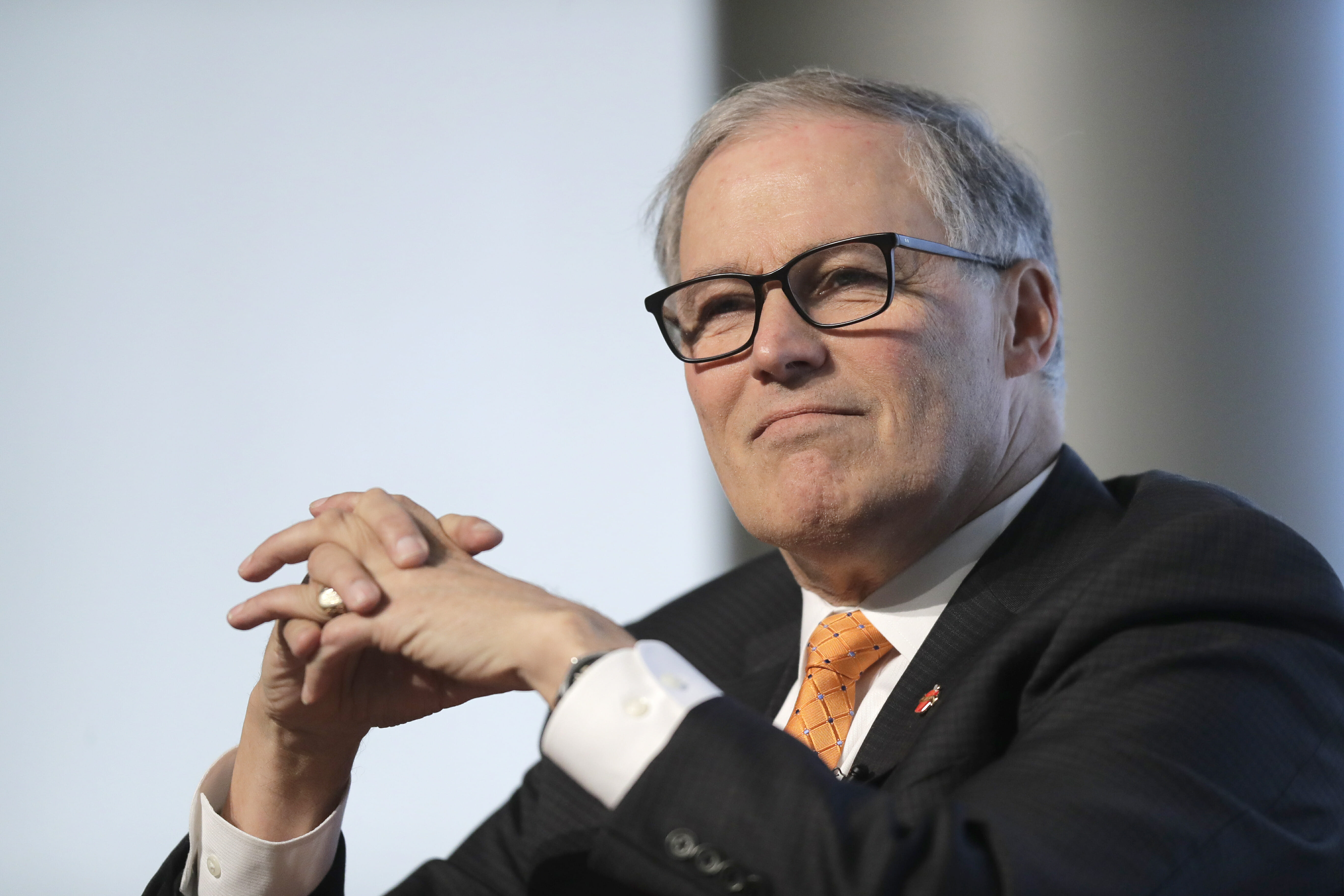
Jay Inslee touts $9 trillion climate plan as economic boom
Democratic presidential candidate Jay Inslee is pitching a $9 trillion-plus climate action plan that he touts as an economic renaissance and scientific necessity, putting the Washington governor at the forefront of White House hopefuls pushing for sweeping action to combat the causes and effects of a warming planet.
Inslee compares his “Evergreen Economy” plan, which combines public and private spending, to President Franklin Roosevelt’s New Deal, the mobilization of the U.S. manufacturing base during World War II and the 1960s NASA mission to reach the moon.
“We didn’t go to the moon because it was easy, but because it was hard,” Inslee told The Associated Press ahead of the release of his 38-page plan on Thursday. “We need a common purpose … that meets the scientific necessity.”
Inslee’s proposal comes as some Democrats on Capitol Hill push a Green New Deal with a similar focus, but the former congressman, who has spent decades as a leading advocate for combating rising carbon levels, is seeking to carve out his own path on the issue.
The plan would marshal 28 new or existing programs to shift U.S energy markets from fossil fuel dependence to renewable sources; transform U.S. automobile manufacturing and construction practices; and remake the nation’s infrastructure from public transit to municipal water and rural electric cooperatives.
Inslee projects about $300 billion in annual government spending over the first decade of the plan, with incentives he says will generate about $600 billion in matching private-sector investment in such areas as expanding solar energy and rebuilding dilapidated water systems like the Flint, Michigan, infrastructure that has garnered national headlines.
Among Inslee’s ideas are a ReBuild America program that would help retrofit existing public and private structures to meet new energy standards and a new version of the post-World War II “G.I. Bill” targeted to help coal industry workers who lose jobs in a transition to renewable energy. The coal worker aid would include guarantees for health insurance and pension benefits, in addition to funds for career training.
Inslee and his aides note that many of the ideas stem from public and private initiatives already being undertaken in cities and states around the country. Aides say Inslee plans a series of events highlighting some of those efforts. He appeared Thursday at a wastewater treatment plant in Washington, D.C., that uses thermal hydrolysis to convert wastewater into electricity.
Inslee already had called for setting standards that would require the nation’s entire electrical grid and all new vehicles and buildings to be carbon pollution free by 2030, while phasing out all coal-fired power by 2035. His latest proposal adds additional goals, attaches a price tag and details how the federal government would meet them.
“There is no middle ground on climate,” Inslee said, alluding to recent reports that former Vice President Joe Biden, a Democratic presidential front-runner, might pursue a more limited approach to combat the effects of increasing carbon dioxide levels in Earth’s atmosphere.
Biden has pushed back on those reports and promises to unveil his climate-change platform in the coming days, the first of what his aides say will be a series of major policy proposals. Another 2020 presidential candidate, former Texas Rep. Beto O’Rourke, has offered a climate policy that calls for $5 trillion of public and private spending over a decade.
O’Rourke does not call for as aggressive a timeline as Inslee has for reducing carbon emissions.
Inslee acknowledges that getting such sweeping proposals through the existing Congress is a near impossibility. Inslee’s own historical references — FDR’s New Deal and World War II mobilization, John F. Kennedy’s NASA investments — all occurred when Democrats had controlling majorities in Congress. In FDR’s case, New Deal programs were passed using large Democratic advantages.
Democrats today must contend with a Republican Senate, and they face an uphill battle to flip enough seats in 2020 to reclaim the majority. Senate Majority Leader Mitch McConnell, meanwhile, has declared himself “the Grim Reaper” and promised to block policies he dismisses as socialist. Even Democratic House Speaker Nancy Pelosi is an open skeptic of the Green New Deal resolution pushed by progressive favorite and freshman Rep. Alexandria Ocasio-Cortez.
Inslee says combating those dynamics requires electing more Democrats and eliminating the Senate filibuster, but also approaching the climate discussion without getting caught up in ideological labels.
“We need a president guided by science,” he said. “We need a president who uses the bully pulpit.”
___
Inslee’s “Evergreen Economy Plan” on the web: https://jayinslee.com/evergreen
___
Follow Barrow on Twitter at https://twitter.com/BillBarrowAP
The Western Journal has not reviewed this Associated Press story prior to publication. Therefore, it may contain editorial bias or may in some other way not meet our normal editorial standards. It is provided to our readers as a service from The Western Journal.
Truth and Accuracy
We are committed to truth and accuracy in all of our journalism. Read our editorial standards.
Advertise with The Western Journal and reach millions of highly engaged readers, while supporting our work. Advertise Today.












